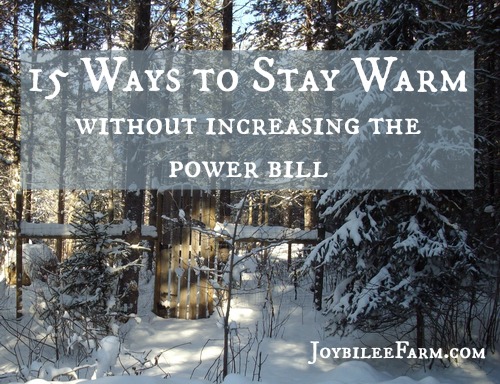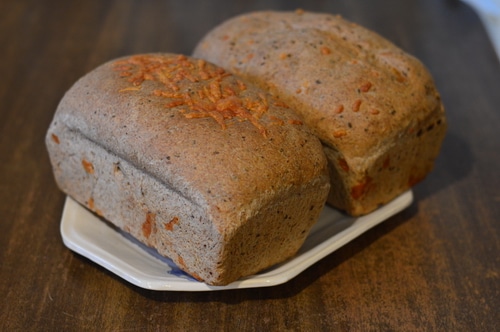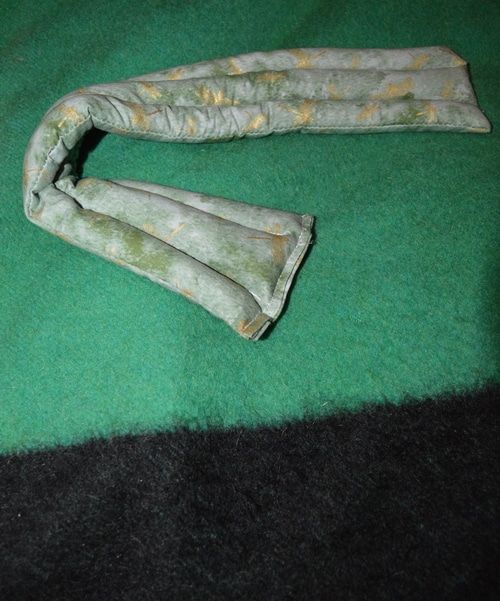
Is there a way to maintain your frugal lifestyle and still stay warm in the winter on the homestead? While in the city and even in the country in a home, when you’re on the grid you can simply turn up the thermostat to stay warm.
Of course, that will increase your power costs. Your ultimate goal is learning these ways to stay warm in winter without turning up the heat.
When you live on a homestead in the country, you lose some of the heat sink properties of city life. While the mountains retain some heat from the summer sun for several months, by February the rocks are cold, the air is colder. On a clear night, the temperature can drop fast and lethally. How can you stay warm when the temperature is plummeting?
Snow offers some insulation from the winter cold, while it stays on the roof. But let it warm up from the heat of the house, escaping through the ceiling and it will slide down in the afternoon sun. You can’t count on it.
The main places where heat escapes are through the windows, through the doors, through the roof, and through uninsulated walls. Dealing with these areas first can hold in the heat of your wood stove or furnace, keeping you more comfortable, as well as saving you fuel costs. If you maintain an off-grid home, it is even more important to stop the heat leaks to stay warm. Here are some tips to help you stay warm without turning up the thermostat if you have one.
Stopping drafts where they enter your home
1. Cover the windows to stay warm in the winter
While in the country you don’t necessarily need curtains to give you privacy, you will want curtains or blinds to keep out the summer sun and the winter cold. Open them during fine days to let in the heat of the sun. Close them tight on clear nights to hold the heat in. Even double and triple-paned glass will let out the inside heat, so by adding some insulation you can hold the heat a bit longer.
2. Add storm windows, shutters, or plastic to the outside of your windows.
Adding an extra layer of insulation to the outside of the windows, holds some dead air between the cold outdoors and the warm indoors, holding in the heat. In the Old Country, this was done with wooden shutters, that required going outside to close them each night and open them each morning.
Storm windows are similar to shutters but have a pane of glass which allows light through. They were put on at the beginning of winter and left on until spring. Plastic sheets are used today for the same purpose. Although they are usually only good for one season of use and are discarded in Spring, with the attendant eco-logical problems that plastics have. If you own your home or are building consider investing in storm windows or shutters, they are less work than plastic and cheaper to use when the cost is spread over many years.
3. Create quilts or blankets for the windows.
Our grandmothers used quilts and tapestries against walls and windows to hold in the heat in an uninsulated house. Hand made quilts add beauty to a rural home. They keep in the warmth and insulate walls and windows from the winter cold.
Quilts used on windows will degrade over time as the fibers are exposed to UV rays, so keep this in mind when choosing fabric for the quilt backing. Wool batting is the ideal batting to use when creating window quilts, as the wool is antibacterial, anti-fungal, and resists molds and mildew that you might get against your windows if you heat with wood, in an area of high humidity. Quilts with wool batting need to be hand-washed, though, so consider this aspect when choosing your materials.
Wool blankets also offer insulation on windows and are a temporary solution to an especially severe cold snap. They can be pinned with clothes pegs to the existing curtain rod for temporary insulation in an emergency. This is especially helpful in a child’s room, where the blankets might be tossed off in sleep. Wool blankets should be washed by hand or on the delicate cycle of your washing machine. And hang to dry, don’t stuff them in your clothes dryer.
4. Stop drafts at doors and windows
While most modern homes are equipped with draft stoppers along the bottom edge of external doors, when a house settles after building, these often stop being efficient. To check if your draft stoppers are working, just walk barefoot in front of the door. If you feel cold air by your feet, you may need to create an additional draft stopper in cold weather. In a pinch, a rolled-up towel placed along the bottom of a door jam will keep the cold air out.
For a long term solution, draft snakes, or any long tube that has appropriate insulation to act as an air sink, will help keep your home warmer. The felted arm of a thrift store sweater might be the perfect draft snake in a pinch, stuffed with plastic bags or wool batting to hold in air and give it weight.
Don’t forget to check patio doors and picture windows. The large uninsulated surface often allows cold air to pour into your home under drapes and blinds. Quilts and draft snakes can stop this warm air loss and make your home more comfortable.
Keeping your body warm
5. Dress in layers and have a layer of natural wool, or silk next to your skin.
Cotton is cold and holds moisture next to your skin. This is cooling in summer but will chill you in winter.
Silk and wool both wick moisture away from your skin and insulate you with your own body heat. Bonus is that both silk and wool are naturally antibacterial and soil-resistant, so they also keep you smelling sweet and clean. They don’t need to be washed as often as cotton.
If you are allergic to wool or silk, consider investing in cashmere, alpaca or quivit for this underlayer. But silk is by far the least expensive.
Have an outer layer of cotton, wool, or additional silk over the underlayer and then a sweater that you can remove if you get too warm. Layers are your best friend when looking at ways to stay warm in winter, without turning up the heat.
6. Spread wool blankets and couch throws around your house to keep in the warmth and cheer.
On really cold days, we have wool throws or wool blankets on each couch and chair as well, to keep us warm while we read. Since we heat with wood some rooms are warmer than others, and the high ceiling in our living room makes it difficult on a really cold night to maintain a comfortable temperature in our log house.
7. Close off unused rooms and bedrooms
By closing bedroom doors and closing off rooms that aren’t used frequently, the warmth produced by your wood stove or furnace can be focused on the rooms that you do use. Bedroom doors can be opened a few hours before bedtime but kept shut during the day. They will heat up faster once the rest of the house is warm.
8. Open a window in the house away from the room that your wood stove is in.
Just open it a tiny bit or if there is a lot of heat escaping through the window, leave it closed but lift the curtain at the bottom just a bit. This keeps fresh oxygen in your home and helps preserve air quality. The cold air will draw the heat through your home as heat moves from hot areas to colder areas. Use airflow wisely as one of the ways to stay warm in winter.
9. Put a fan on the woodstove
If you heat with wood, install a fan with a sterling engine to move air from the top of the stove through the house, without electricity. No woodstove should be without a sterling engine fan. Try the Caframo Ecofan GS, Black with Gold Blade.
10. Cooking using your oven is one of the great ways to stay warm in winter
The smell of bread or granola cooking warms the body and tricks the mind. If your family is complaining of the cold get the oven warmed up and bake some bread. Hot bread with real butter will help the body stay warm for a while after eating. Use the heat from bread baking to toast up some granola, too.
The wise women of the past would slip in a pot of baked beans on bread baking day, to cook slowly. Beans and bread make a complete protein, and when it’s cold the carbs help the body stay warm. Be sure to use real butter on the bread and a bit of animal protein and saturated fat in the beans to increase the metabolic rate of your body and keep the warmth.
It’s hard to keep the body warm on a low-fat diet or a diet high in vegetable oils.
11. Keep the family together in the warmest room of your home and play games, read stories aloud and talk.
Watching television or playing computer games is a cold activity that increases isolation and increases complaining. On very cold nights, consider calling it a family night and do something together to keep the family in the warmest room of the house, and to increase the warmth of togetherness.
Go to bed to stay warm in the winter
12. Reinstitute the family bed.
While your older children might not join you in your bed, younger children will benefit from sharing the bed with Mom and Dad. Older children can be bedded together to keep each other warm on very cold nights. My brother and I shared a bed until we were about 4, with each of us taking one end of the bed for a headboard. This kept us warmer than if we had a bed alone.
13. Hot rocks, hot water bottles, and flax bags.
The initial time in a cold bed is the most uncomfortable. Our pioneer grandmothers warmed up the bed beforehand by placing bed warming pans in beds before sending the children to sleep in their shared beds. The bedpan held prewarmed rocks from the fireplace and was left at the bottom of the bed during sleep. Today the hot water bottle replaces the bed warmer. But hot water bottles are susceptible to leaks. A cloth bag filled with flax, wheat or beans can be heated in the warming cabinet of your wood stove, or in the microwave or oven and be placed in the bed to prewarm the foot zone before bedtime.
In a pinch, you can create a warming bag by filling a single sock, which has lost its mate, with dried beans, flaxseed, or whole wheat. And tying the top closed with a knot. Nicer bags can be created with ticking and patterned cotton fabric. Narrow rectangles work best, as these can be folded over cold toes or cuddled over the tummy to soothe a child who can’t fall asleep in the cold.
14. Wool blankets
We place a wool blanket (purchased from the thrift store) under the bottom sheet of our bed to hold in the body heat and act as a barrier against the cold of the polyester mattress. We also have two wool blankets over top of the sheets to hold our own body heat in winter. In our uninsulated log home, this has allowed us to stay warm even on very cold nights, without having undue weight on top of us. In fact, we sleep with the window open, even on cold nights.
Rev up your metabolism
15. Drink green and white tea or Masala tea.
Tea rather than coffee is the best drink for winter days. Tea increases your internal furnace and causes your body to increase its temperature, while coffee doesn’t. Tea is also lower in calories and carbs than other hot drinks like rum toddies or hot chocolate. Spicy tea and other spicy foods also increase your metabolic rate and help you warm up. Don’t omit breakfast, as you will feel colder if your body is forced to survive on coffee alone in the morning.
Spices like turmeric, cayenne peppers, and sweet cinnamon all help your metabolism rev a little higher.
Your Turn:
With these suggestions to help you stay warm in winter, I am just scratching the surface. There are many other ways that I could add. How do you stay warm in winter and keep cheerful and comfortable as the winter season wears on? What advice might you give to someone new to a northern winter?

BTU of 25 firewood species chart
Explore the BTU ratings of 25 different firewood species with this downloadable chart and get my best tips for Firewood storage and safety by clicking the pink Free download button below.






I don’t have any extra quilts to use on my sliding glass doors so I purchased a couple of moving blankets from Harbor Freight. They were very inexpensive and work well under my drapes.
One thing you didn’t mention is ceiling fans – reversing them during winter. I do that, although I’m still not sure how much it helps.